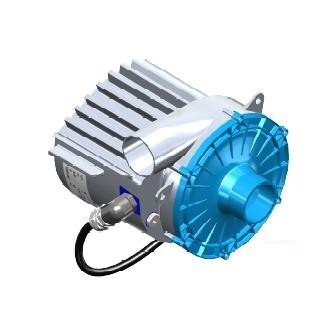
The blower 1045 is one stage radial blower with a tangential air outlet and an axial air intake. A direct current supply is used, and depending on the type, the voltage is between 16V and 32V. The drive is an integrated conventional 3-phase BLDC motor. This motor is maintenance-free and therefore achieves a significantly longer working life than commutator motors.
For geometric data, please refer to the dimensional drawing. The blower weighs approx. 3.8 kg
1. Electrical connection
The blowers should be operated at the indicated voltages. The supply should be free of interferences and should permit relatively high currents (despite inrush current limitation for the motor, inrush currents are relatively high and can result in a voltage drop). The 24V supply voltage must lie within a range of 16V to 32V. If the voltage is less than 16V, the controller will be switched off. When the blower is connected to the supply voltage, it should be ensured that internal capacitors are connected in parallel to the connection leads. These capacitors are charged when the operating voltage is applied, and may still be charged after disconnecting.
Connection configuration (example)
2. Control voltage input
The control voltage input can be either analog (0 to 10V). At a voltage between 0 and approx. 1.8V the blower stops. At a voltage of 10V, the blower operates at maximum power; apart from the control voltage, this depends on the loading of the blower and the actual operating voltage applied. Depending on the connection configuration, the control voltage input (Vs) can be directly biased with 0 to 10V, or this input is applied via a switch to the internal supply voltage of 10V, or a control voltage can be generated without additional electronics through a potentiometer and the internal supply voltage. When operating with a potentiometer or a switch, it should be noted that the internal supply voltage of 10V (10mA) is not short circuit proof, and faulty wiring can result in damage to the internal controller. It is recommended to connect a 1kOhm resistance in series to the control voltage input to protect the control voltage input against short-term overvoltage (>10V).
The blower has various protective switchings:
3.1 Undervoltage Cut-Out
If the voltage drops below a programmed minimum value, the blower cuts out. If this value is exceeded, the blower automatically switches on again.
3.2 Overcurrent Limitation
If the internally defined current value is exceeded, the output stage is stopped and is immediately restarted when the current falls below this value.
If an internal temperature limit value is exceeded, the output of the blower is reduced to maintain the cooling function and to reduce self-heating. If the temperature falls back below the internal limit, the blower goes back again to the output set by the rotational speed input.
3.4 Blocking Protection
If an overcurrent is detected for longer than 1s or an overcurrent occurs twice within a short period, the motor is switched off. The motor can be operated again only after the blockage has been removed and the voltage has been disconnected.
If required, an additional voltage (5V; 100mA) can be taken off for the supply of other additional electronic components. This voltage cannot be assumed to be “safe” unless the motor supply voltage is also “safe”. It is recommended to dejam the additional leads using a ferrite ring core or a split ferrite.
4. Mechanical Connection
Optimally, the blower is operated with a vertical axis of rotation and the intake opening on the underside.
The intake opening must be protected from contact by a grille or similar measures (Danger of injury!). The blower should be firmly fixed in place using the 3 flanges and 7 mm drillings, as there can be a strong moment of reaction due to the relatively high start-up moment of the motor.
5. Noise Level
The measured noise level of this blower type is lower than 72 dB.